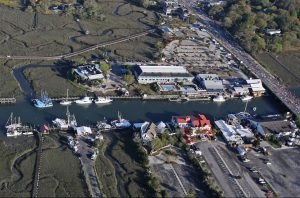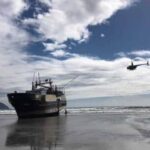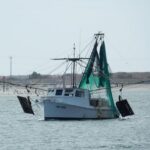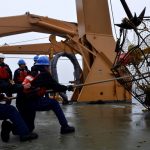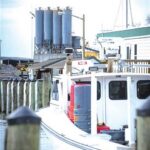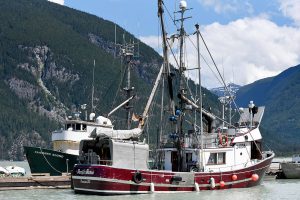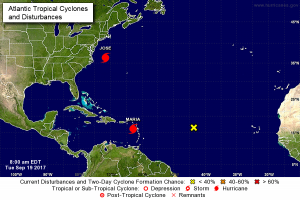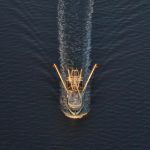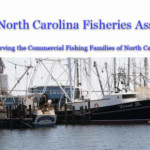Tag Archives: Mid-Atlantic
Eye-opening report by NOAA on fisheries and offshore wind farms
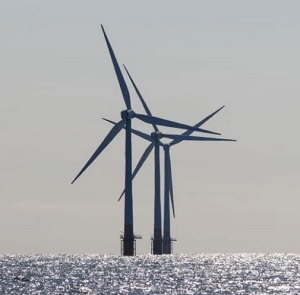 Offshore wind-energy installations “wind farms” are expanding along the East Coast of the United States as a way to increase the use of renewable energy, but these installations are not without their own significant impacts on marine resources and their associated fisheries. They have innocuous-sounding names such as Revolution Wind, Sunrise Wind, Mayflower Wind Phase 1 and Park City Wind. The Bureau of Ocean Energy Management is the federal agency responsible for offshore-energy exploration and development in the US. To date, BOEM has leased approximately 1.7 million acres in the northeast and mid-Atlantic US outer continental shelf for offshore wind development, with approximately 25 active leases from Cape Cod to Cape Hatteras. And in late August, BOEM and the Department of the Interior announced that they will hold the first offshore wind-energy lease sale in the Gulf of Mexico. >>click to read<< 10:30
Offshore wind-energy installations “wind farms” are expanding along the East Coast of the United States as a way to increase the use of renewable energy, but these installations are not without their own significant impacts on marine resources and their associated fisheries. They have innocuous-sounding names such as Revolution Wind, Sunrise Wind, Mayflower Wind Phase 1 and Park City Wind. The Bureau of Ocean Energy Management is the federal agency responsible for offshore-energy exploration and development in the US. To date, BOEM has leased approximately 1.7 million acres in the northeast and mid-Atlantic US outer continental shelf for offshore wind development, with approximately 25 active leases from Cape Cod to Cape Hatteras. And in late August, BOEM and the Department of the Interior announced that they will hold the first offshore wind-energy lease sale in the Gulf of Mexico. >>click to read<< 10:30

Doomed to Fail: In the Northeast and Mid-Atlantic, a quiet reckoning over offshore wind
Crippling European electricity prices, soaring Northeastern heating bills, looming diesel-fuel shortages, and OPEC+ drama have captured headlines for months. More quietly, offshore-wind energy developers are discovering their projects’ economic infeasibility, undermining states’ offshore-wind goal of generating 40,000 MW by 2040. The Biden Administration must recognize this is a pipe dream, or it will cost Americans billions trying to salvage an industry doomed to fail. October brought the first sign of troubles,,, Massachusetts’ Commonwealth Wind, Mayflower Wind project, New Jersey Ocean Wind. All three project developers originally negotiated prices far above wholesale market prices. All three qualified for a production tax credit and additional offshore-wind state tax credits. All three will qualify for a new 30 percent offshore wind investment tax credit which was not available when they made their initial bids. Yet this federal and state largesse has still failed to keep the projects afloat. >click to read this< 18:17
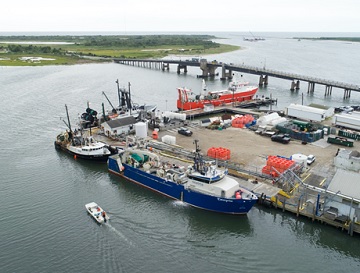
Mid-Water Herring Trawlers to Return to Inshore Waters – Court Overturns Exclusion Zone
Herring fishermen from New England and the Mid-Atlantic won a crucial decision last week when a federal judge in Boston ruled in their favor against an exclusion zone in Northeast U.S. waters. The court ruled that a National Marine Fisheries Service (NMFS) measure excluding the mid-water trawl fleet from productive inshore fishing grounds violated the Magnuson-Stevens Act, the nation’s premier fisheries law. The lawsuit was brought by the Sustainable Fisheries Coalition (SFC), a trade group representing herring and mackerel fishing companies. >click to read< 08:16
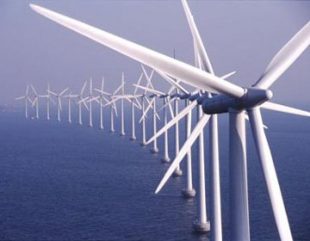
The Frightful Cost of Virginia Offshore Wind
On November 6, Virginia’s State Corporation Commission (SCC) regulatory agency approved a project to construct wind turbines near Virginia Beach. The plan calls for construction of turbines 27 miles off the coast,,, The project, named Coastal Virginia Offshore Wind (CVOW), will be the first offshore wind project in the mid-Atlantic.,, The wholesale price for electricity in Virginia is about 3 cents per kilowatt-hour (kWh).,,The electricity produced from the two offshore turbines will receive 78 cents per kWh, or a staggering 26 times the wholesale price. >click to read<21:36

Wind Turbine Development and the future of fishing? Nils E. Stolpe/FishNet USA
Let’s start with commercial fishing perspectives on wind farms in the North Sea: Seventeen fishing vessels docked in the centre of Amsterdam, a city that built its wealth and prosperity on the herring fishery. Between 600 and 700 fishermen from Holland and Belgium arrived in the city for a peaceful but highly visible protest that was followed by dozens of journalists.,,, In spite of the fact that in the U.S. our experience with producing electricity with offshore wind turbines is virtually nonexistent, we are apparently well on the way to committing billions of dollars to the effort – and most of that effort is going to be in the waters off New England and the mid-Atlantic. How much experience do we have with offshore wind turbines in the United States? >click to read<12:23
New England, Mid-Atlantic States Lead Nation in Volume and Value of Several Key Fisheries
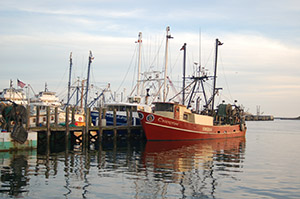 NOAA Fisheries has released the Fisheries of the U. S. 2016 report, and once again New Bedford, Mass. was the leading U.S. port by value and American lobsters were the nation’s most valuable landed species. Alaska led all states in the value and volume of commercial landings, with 5.6 billion pounds valued at $1.6 billion. Maine and Massachusetts ranked second and third in the value of landings at $633.6 million and $552.1 million, respectively. American lobsters were the nation’s top-valued species landed, with crabs second and scallops third. Alaska pollock ranked first in volume of landings, followed by menhaden and Pacific cod. click here to read the story 17:39
NOAA Fisheries has released the Fisheries of the U. S. 2016 report, and once again New Bedford, Mass. was the leading U.S. port by value and American lobsters were the nation’s most valuable landed species. Alaska led all states in the value and volume of commercial landings, with 5.6 billion pounds valued at $1.6 billion. Maine and Massachusetts ranked second and third in the value of landings at $633.6 million and $552.1 million, respectively. American lobsters were the nation’s top-valued species landed, with crabs second and scallops third. Alaska pollock ranked first in volume of landings, followed by menhaden and Pacific cod. click here to read the story 17:39
NOAA – Dolphin deaths an “Unusual Mortality Event” in the Mid-Atlantic
 Under the Marine Mammal Protection Act of 1972 (as amended), an Unusual Mortality Event (UME) has been declared for bottlenose dolphins in the Mid-Atlantic region from early July 2013 through the present. [email protected]
Under the Marine Mammal Protection Act of 1972 (as amended), an Unusual Mortality Event (UME) has been declared for bottlenose dolphins in the Mid-Atlantic region from early July 2013 through the present. [email protected]

































